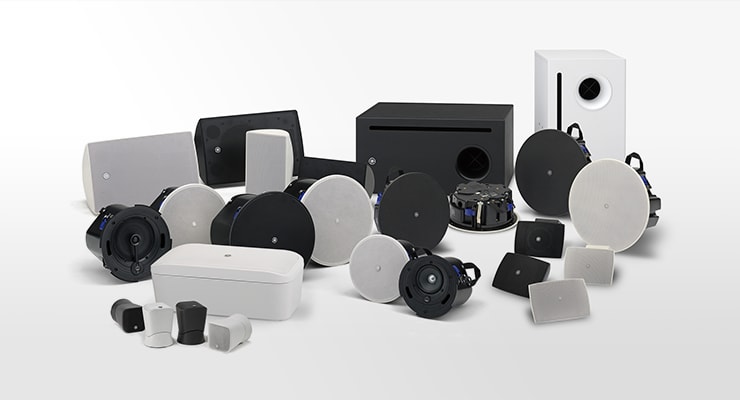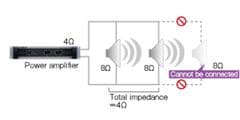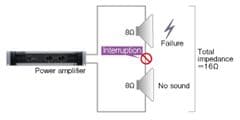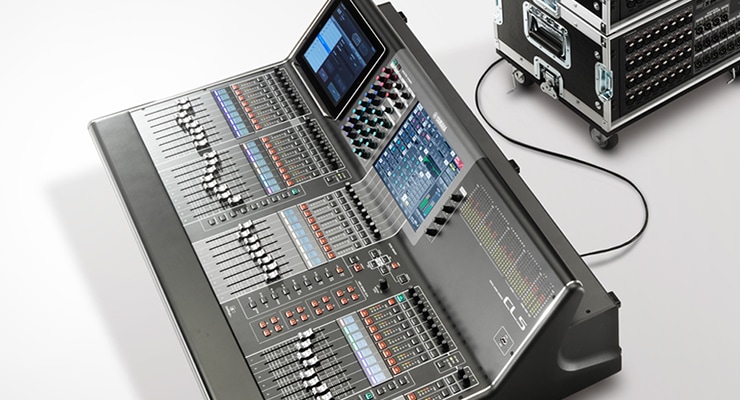Better Sound for Commercial Installations
Part 2: Amplifers and Speakers

03. High-impedance and Low-impedance Connections
A major decision that sound professionals must make when choosing power amplifiers is whether a high-impedance or low-impedance speaker system is to be used. This is an aspect of sound installation design that is not widely known, but it is a key consideration when deciding on the type and number of power amplifiers to deploy.
Impedance is Resistance to AC Current
Impedance is a complicated subject that requires some in-depth study. A simplified explanation follows. "Ohm's law" is a fundamental principle of electronics that describes the relationship between voltage, current, and resistance. Voltage corresponds to electrical pressure, current corresponds to flow, and resistance is the amount of opposition to that flow. Resistance and impedance are similar, but while resistance applies mostly to DC (direct current), impedance refers to the opposition of AC (alternating current) flow. The difference can be ignored for the sake of our discussion here.
To make things clearer you can think of a supply of electricity as a dam. Voltage corresponds to the pressure of the water flowing from the dam, current is the amount (volume) of water flowing from the dam, and resistance is the valve that controls the amount of water flowing from the dam. Closing the valve - increasing the impedance - reduces the amount of flow, but the pressure remains the same. Now that we understand that relationship, we can talk abut high-impedance and low-impedance speaker system connections.
High-impedance and Low-impedance Connections

For a high-impedance connection a speaker transformer that raises the impedance to several hundred or thousand ohms is added to the speaker system. This allows the speaker system to be effectively driven with much lower current than is required for a low-impedance system. That, in turn, makes it possible to connect a larger number of speaker systems to each power amplifier output. High-impedance speaker connections work at a specific maximum voltage - usually 70 or 100 volts - and are therefore also referred to as "constant voltage" speaker systems (the label "constant voltage" is somewhat misleading: the actual output voltage fluctuates according to the input signal).
(Figure: High-impedance speaker connection)

For a more orthodox low-impedance speaker connection, the power amplifier is directly connected to a speaker system that has an inherent impedance of 4 ~ 16 ohms.
The difference between these types of connection are outlined below.
(Figure: Low-impedance speaker connection)
Power Amplifier to Speaker Connections
High Impedance
It is necessary to use a power amplifier that has been specifically designed for high-impedance connection (100 or 70 volt line), and one that can deliver more than the total rated power input capacity of all transformer-equipped speakers in the system.
Low Impedance
A power amplifier that can handle the impedance of the speaker system must be selected. If the amplifier and speaker system are not properly matched, the full performance capabilities of the power amplifier will not be achieved. It is also important to select an amplifier that is capable of delivering the maximum rated input (PGM) of the speaker system in order to achieve maximum output without distortion. A power amp that doesn't have enough power can easily cause distortion and even damage the speaker system.
Multiple Speaker System Drive Capability High Impedance
As long as the total nominal power input rating for all speakers is within the power output capability of the amplifier, any number of speaker systems can be connected in parallel. In a high-impedance installation, the power input rating is determined by the speaker transformers used. If, for example, a two-channel power amplifier that can deliver 200 watts per channel is used with speaker systems that are equipped with speaker transformers that result in a rated power input of 10 watts, up to 20 speaker systems can be driven by each channel. That's as many as 40 speaker systems total for both channels. In a high-impedance installation it is also possible to simultaneously drive speaker systems that have different input power ratings.
Figure: If the total speaker system input power rating is less than the power amplifier's rated output, any number of speaker system can be connected.
Low Impedance
Normally only one speaker system is connected to each amplifier channel, as shown in the diagram. The number of speaker systems that can be connected is limited to the number of channels provided by the power amplifier.
(Figure: Standard low-impedance connection: one speaker system per channel)

When multiple speakers systems having the same impedance are connected in parallel, the total impedance becomes the individual speaker system impedance divided by the number of systems connected. In the example, up to two 8-ohm speaker systems can be connected in parallel to a power amplifier with 4-ohm drive capability, resulting in a total impedance of 4 ohms (8 ohms ÷ 2 speaker systems = 4 ohms).
Figure: Parallel connection

The second method is series connection. In this case the total impedance is simply the sum of the impedances of the speaker systems connected. But as you can see in the series connection wiring diagram, if one speaker system fails the second speaker system will be affected as well. The limitations imposed by low-impedance connections mean that if multiple speaker systems are to be connected, a high-impedance installation is usually the best choice.
(Figure: Series connection)
Transmission Distance and Efficiency
The cables that transmit electric signals have resistance. The resistance in short cables is small enough that it can be ignored, but as transmission distance and cable length increase, resistance can increase to the point that signal loss and degradation occur. That can mean reduced output level and sound quality. Below we examine the merits and demerits of low-impedance and high-impedance connections in relation to transmission over significant distances.
High Impedance
If the resistance of a long cable in a high-impedance system reaches 8 ohms, as shown in the diagram, that value is small enough in relation to the 1,000 ohm (1 kohms) impedance of the speaker transformer that the transmission loss will be insignificant and essentially no degradation of the audio signal will occur.
(Figure: Efficiency is not affected by cable resistance)
Low Impedance

For short distances over which cable resistance is insignificant, low-impedance connection allows the power amp to be directly connected to the speaker system without the need for speaker transformers. That means that the full performance potential of amp and speakers can be taken advantage of for sound quality that is superior to high-impedance installations. And since only one speaker system is usually connected to each amplifier channel, different audio signals can be sent to each speaker system, or "zone," as required.
But in a situation like the one shown in the diagram, where a long cable with a resistance of 8 ohms is required, transmission loss will theoretically result in the output level being reduced by half because the impedance of the speaker system itself is only 8 ohms. Half of the power gets absorbed by the cable, and only the remaining half is available to drive the speaker. So for low-impedance installations it is necessary to either keep the cables short enough that cable resistance is not an issue, or use thicker cables that have lower resistance for longer runs, for example.
(Figure: Long cable runs can result in significant transmission loss)
Because of the characteristics described above, high-impedance installations are often used at schools, train stations, shopping centers, hotels, and other facilities where the primary goal is to distribute sound over a wide area via a large number of speaker systems. Low-impedance installations, on the other hand, make it easy to send different signals to different speaker systems/zones with higher audio quality as long as the transmission distance are kept short, and are therefore preferred for installations that deliver music, such as BGM in offices or stores.
Power Amplifier Selection

(Figure: Yamaha power amplifiers feature EEEngine (Energy Efficient Engine) and other technology that reduces power consumption while delivering high sound quality and power output)
As we have just seen, once the type and number of speaker systems to be used and whether high-impedance or low-impedance connections are to be used have been determined, the required power amplifier specifications can be calculated. Once that has been done we can start choosing specific power amplifier models.
Power amplifiers handle higher voltage and current than any other component in the audio chain, and have a significant effect on overall sound quality. Although they are not as visible as mixers or speaker systems, and are generally seen as playing more of a support role, power amplifiers are actually cornerstones that have a large influence on the quality of every sound system. It is therefore important to select power amplifiers of the highest quality.
Because of the high voltage and current that power amplifiers are required to handle, attention must be paid to electrical parameters other than just sound quality and output power. Power consumption is one such parameter. Lower power consumption means less heat generation, and that means longer life for internal parts: the amp is likely to be more durable and last longer. A lower electricity bill will also contribute to reduced long-term operating cost.
In the next section we'll discuss mixing and processing. Compared to speakers and power amplifiers, the basic principles of which are well established, digital technology and other innovations are resulting in astonishing advances in mixing and processing capabilities and procedures. There's plenty more to learn!
Contents
The sound systems that broadcast the information you're hearing have been carefully designed and installed to suit the needs of each individual facility.
This series offers information aimed at achieving the best possible sound in commercial installations, from the basics to equipment selection and day-to-day operation.








